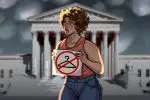In recent weeks, women have been lining the streets of Southern Capitol buildings to protest several states’ controversial proposed bans on abortion and opposition to the historic Roe v. Wade ruling. Some protestors wore costumes inspired by “The Handmaid’s Tale,” illustrating how intense these decisions are to broader society, and notably, to women’s rights.
In fact, the past month saw some of the most intense anti-abortion legislation in U.S. history passed. On May 15, Gov. Kay Ivey signed the Alabama Human Life Protection Act, banning abortion, even in cases of rape and incest, while also punishing doctors who perform an abortion with up to 99 years in prison.
Louisiana also made a similar move last week with the “Heartbeat Bill,” which prohibits procedures after six weeks or when a fetus forms a pulse; it is now the fifth state to pass it into law, joining Georgia, Kentucky, Mississippi and Ohio. Other states consider tighter restriction than the Roe v. Wade trial suggests.
Citizens and politicians alike claim the laws are unconstitutional and have started mobilizing to appeal the so-called breach in Supreme Court ruling. The question is, how are the “Heartbelt” states able to restrict abortion, acting in clear opposition to the U.S. Constitution?
In 1973, Texas citizen Norma Leah Nelson McCorvey — better known by her legal pseudonym, “Jane Roe” — challenged the state’s strict abortion laws by bringing her case to the Supreme Court. McCorvey won with a 7-2 ruling, and the final decision proclaimed illegal abortion unconstitutional.
However, the case was disputed in 1992 with Planned Parenthood v. Casey, which allowed states to restrict it as long as it did not create “a substantial obstacle in the path of a woman seeking abortion.” Consequently, states began to implement Targeted Regulation of Abortion Providers laws, which have led to the maximum-restriction measures seen today.
The 1992 case tried and failed to make abortion illegal, but the current state of affairs is leading to a future where abortion is banned outright. Similar to Planned Parenthood v. Casey, the Supreme Court currently has a conservative majority with the addition of Brett Kavanaugh. In addition, Trump pledged during his campaign to overturn “Roe,” insisting it “will happen automatically in my opinion because I am putting pro-life justices on the court.” The key difference between then and now, though, is growing support from state governments.
While many haven’t officially passed legislation, states are beginning to bring abortion restriction to the table. Utah, Florida and Iowa have suggested the Heartbeat Bill, but it has failed to pass in each state. As the more conservative states mobilize against abortion, Democratic regions are introducing laws to protect it. New York, Vermont and Maine are expanding funds and term length, while Nevada is dissolving its requirement for doctors to explain the “emotional implications.”
It’s obvious the nation is experiencing increased strain from these budded disputes of Roe v. Wade, but whichever side you take, it’s important to understand key problems associated with current legislation.
1. Demographics of Voting Politicians
Abortion laws are directed toward people who can become pregnant and, of that, women are the majority. However, Alabama’s intense restrictions were passed by 25 male votes. It’s no surprise that there are more male lawmakers in politics, but it is outrageous that no women were associated with the bill’s authorization.
On and offline, activists are furious with the misrepresentation, believing that men have no jurisdiction over what a woman decides to do with her own body. Moreover, there is serious debate over the validity of the laws across the nation concerning women’s personal rights.
2. Lack of LGBTQ+ Representation
Another concern that has unfortunately been brushed aside in the midst of the abortion conversation is queer representation. Legislation exclusively addresses women, leaving out people that might identify differently but still have a functioning uterus.
The bills not only disregard multi-gender pronouns but also bar LGBTQ+ citizens from accessible healthcare. Along with abortion procedures, Planned Parenthood provides care for HIV, hormone-replacement therapy and other forms of positive, queer-related treatment. Associated organizations like the Transgender Law Center have commented, “These are the… communities most vulnerable to sexual violence.”
3. The Heartbeat Bill’s Six-Week Maximum
The Heartbelt region has issued a six-week maximum for abortion procedures, which is around the time that a fetus develops a heartbeat. However, symptoms are hard to detect until at least 12 weeks of pregnancy, making it almost impossible for people to apply for care once they recognize what they are carrying.
Roe v. Wade asserts that the legal threshold is around 24 weeks or when visible symptoms start to develop. Because the restrictions are three times less than the perimeters set out by Supreme Court precedent, the Heartbeat Bill has been subject to lawsuits and public outcry. Theoretically, women cannot confirm their pregnancy in such a small window and find the treatment they need for their constitutional right.
4. Allows Rape, Incest and Defects
A shocking feature of current anti-abortion legislation is that there are no exceptions for rape or incest. While it does protect women from serious health risks, carrying a child from nonconsensual sex can cause severe emotional and physical trauma, which can sometimes lead to children who are born with defects that induce pain and shorter life spans.
At 17, abortion activist and rape survivor Dina Zirlott was unable to seek treatment because she was too far along, although her fetus had a congenital brain defect. Her child was born blind, deaf and exhibited slow brain functions and chronic pain.
In the span of one year, Zirlott was traumatized by the conception, birth and death of a child she did not ask for. This isn’t just a constitutional matter — it’s about basic human rights.
5. Women’s Choices
Lastly, the legislation limits a women’s ability to choose her own path in life. By completely banning abortion, women who do not consensually conceive are forced into motherhood, potentially jeopardizing their health, careers and happiness.
Roe v. Wade was a step toward gender equality and laws that completely ban abortion are chipping away at its foundation. While some politicians believe that safe, legal and rare is ideal, the outright ban of abortion and clinics is detrimental to women’s health, whether by forbidding the procedures or closing their facilities. As their fundamental right, women deserve to decide how they want to live their lives, and only then can there be true gender equality.
















